all:
day 1.2 2024
directions: multivocal speech performances 2024
rolling 1.2 2024
horizons 2023 - 2024
directions-quartet 2023
Rotation 5 (tour) 2022 -
Crossing - writing solo 2022
crossing - writing group 2022
rite 2022 2022
crossing brutus 2022
Wolkenbewegingen Wandelweiser 2022
wolkenbewegingen movements of clouds 2022
five artists interviews 2021
New Polyphonies (text) 2021
strandtrappen 2021
waterhoentjesfamilie (nY) 2020
book: bewegen - schrijven / moving - writing 2020
clouds-lines 2019 - 2020
book: bewegingen-movements Toine Horvers / Henk Geraedts 1990 - 1980 2019
crossing 2019 2019
Petrichor 3 / Jeroen Jongeleen 2019
portrait Ilse S. 2018
book: liggen / lying 2018
Copying Charlois 2018
reading hans stevens 2018
Double Spiral 3 2017
Rotation 2 2016
Rotation 3 for Tom Johnson 2016
Raag Suha 2016
Rotation 4 2016
DAY am/pm 2015
Rotation 1 2015
Language 2015
Arf Arf and friends 2015
Chartres, one voice 2014
real space/real time 2014
News of the world 2013
Chartres, one hour of sound in a Gothic Cathedral 2013
Mei, geluid van vogels.... 2013
words live 4 2013
one voice Prague 2012 2013
Beijerkoppen 2012
One Voice (S. Vriezen) 2012
cd box Tochnit Aleph, Berlin 2012
Magaio Unison 2012
Zeetijding De Pavilljoens 2012
rolling 7 Luchtsingel 2012
singelstemmen 2012
zangvogels (singing birds) 2012
magaio panorama 2011 = 2012
Copying as a ritual act 2011
Copying as a ritual act 2 2011
zeetijding Maassluis 2011
Vozes de Magaio 2011
Music & Film 2011
copying as a ritual act, publication 2011
waves 6 golven 6 2011
Sound scape 2010
Bakkum Panorama 2010
Writing Lecture, performance 2010
Intimate Selfportrait performance 2 2010
Writing Lecture, publication 2010
Book Tor line Panorama 2010
Dordtselaanportretten Deventer 2009
Words Live 2 2009
Rite 3 2009
Nombres de Calles 2009
Words Live 3 2009
Book Names, sections of the Ear 2009
Tor Line Panorama 2009
Book Names: sections of the Head 2008 - 2009
Tim Etchells' selfportrait 2008
Tim Etchells` selfportrait, performance 2008
Doorzicht 2008
Names: Sections of the brain 2008
Dordtselaanportretten 2008
Words Live 1 2008
Panorama's 2007
Subway solo 2007
Light selfportraits live 2007
Lichtkrant (Light-journal) 2007
Eurasia Poznan 2007
Book Light selfportraits 2006 - 2007
Cross Fading Lights 2006
The Bible 2006
book: Inis Oírr panorama 2006
Book: Intimate selfportrait 2006
Kunstvlaai portraits 2006 2006
Waves 2006
kunstvlaaiportretten 2006
inhalation / exhalation 2006
Trajecten 2005
Intimate Self portrait 2005
Sub urban video lounge 2004 - 2014
sub urban video lounge 2004 - 2014
Subway 2004
Inis Oirr panorama 2004
Passers-by NY 2004
Scheepshoorn (ship's horn) 2004
hoi 2004
Names: head and neck 2004
Rubbings 2004
Passers-by: waves 2004
songs 2003 -
Limestone 2003
Clouds live 2003
Inis Oírr Panorama in four directions 2003
Het Heiligdom (Sanctuary) 2003
Passers-by: clouds 2002 - 2003
Hart-slag (heart beat) 2002
Clouds (Finnegans wake) 2002
Data 2002
Lokaal 2002
Names, Orbit 2002
Names The Brain EMC 2001
Bluestack Mountains 2001
Zeetijding (Ship's names) 2000
Names: Head and Neck, colour 2000
Puszcza Bialowieska 2000
Stream 6 (Calveen) 2000
Dag- Nacht (Day-Night) 2000
Ulice Warszawy (streets of Warsaw) 2000
Rivierenland 2000
Names: sections of the ear 2000
Names, landscape maps 2000
Silence Gothique 1999
Paysage Sonore 1999
Sections of the Ear (anatomic library) 1999
Zeetijding, Performance 1999
IJsselstein Zenderpark (proposal) 1999
Names: Donegal north 1999
Passers-by: Dordtselaan 1999
Names, coronal and sagittal sections of torso 1998
Names, sections of the head 1998
Names: coronal of the body 1998
Names: orbit ear sections 1998
Names, The brain axial sections 1998
Portraits 1998
Europa 1998
Portretten 1998
Names The head Geraedts 1997
Names, sections of the Head 1997
names: city maps 1997
Portrait 1997
Registraties 1996
Names: sections of the head 1996
Names: the world meridians 1996
De huid van de Witte Dame 1996
Clouds 9 Ermer 1995
Names: Crossing Australia 1995
Lecture7 1995
A passage way 1995
Stream 4 1995
Oíleain Arann 1995
Tivoli 1995
Stream 5 (Electro) 1995
names, axial of the body 1995
rite 1994 - 2009
ringwave 5 1994
Stream 2 1994
Lecture 6 1994
Rite 2 study 1994
Sprong (Jump) 1994
Collection 1994
Rite 1 1994
Water levels: tidal areas 1990 1994
Water levels Rhein Deutschland 1989 1993-1994
water levels rivers and lakes 1993-1994
The weather in numbers 1993 - 1994
Clouds 7 1993
The bells of Voorne/Putten 1993
History 1993
Names: Tasmania 1993
Plan drawers 1993
short wave stations 1993
Waves 5 1992
Clouds 6 1992
Tide 1992
Lecture 4 1992
Clouds 8 1992
Pauken (Kettle drums) 1991
Lichtconstructie 1991
Lezing 3 1991
Crossing voices 3 1991
Clouds rolling 1990-1994
The weather in text 1990 -1992
Clouds 4 1990
Lezing 1 1990
Ring 1990
Clouds 5 1990
Lichtwolken / Clouds of Light 1990
Stimmen 2 1989
Clouds 3 (Ermer) 1989
Schrijven 2 / writing 2 1988
Linia Dzwieku 1988
wave 4 1988
dag 2 (beurs) - day 2 (beurs) 1988
Clouds 1 1988
Clouds 2 1988
Oktet 3 1988
Ringwave 4 1988
Vagues 1988
Crossing Voices 2 1988
Dziekanka 1988
drumming The Act NY 1988
Ringwave 2 1987
Ringwave 3 1987
Rolling 5 1987
Rolling 6 1987
Oktet, Welle für Kassel 1987
Durchschnitt/intersection 1987
Wielka 1987
schrijven 1 / writing 1 1987
Rolling 1 1986
Study for wave 1986
Twilight 1986
Stimmen 1986
Rolling 2 1986
Ringwave 1 1986
Waves 2 1986
Crossing Voices 1986
Etmaal voor Berlage 1985
balance 6 1985
meeting 1 1985
Wall 2 1985
Crossing 1984
Study for Crossing 1984
zog - wake 1984
balance 5 1984
Balance 4 1984
Balonnen: studie voor bewegingsstructuur 1984
grenzen - borders 1984
torens - towers 1983
tillen 2 - lifting 2 1983
tillen 3 - lifting 3 1983
day 1- etmaal 1 1983
tillen 1 - lifting 1 1983
balance 3 1983
markeren - marking 1983
dubbele spiraal 1 - double spiral 1 1983
spiraal 4 - spiral 4 1982
balance 2 1982
spiraal 3 - spiral 3 1982
progressie - progression 1982
wand - wall 1982
rolling 1982
blok 1 en 2 - block 1 and 2 1982
spiraal 2 - spiral 2 1981
maat/tijd - size/time 1981
hekwerk - fence 1981
brug - bridge 1981
overbruggen - bridging 1981
kantelen - toppling 1981
hoek 2 - corner 2 1981
springen - jumping 1981
Hangen 1981
Segmenten 1981
trap - stairs 1981
Be-tekening 1981
vormveranderingen/changes of shape 1980 - ongoing
talud / slope 1980
balance 1 1980
kijkvorm 2 / view form 2 1980
spiraal 1 spiral 1 1980
hoek 1 - corner 1 1980
kubus / cube 1980
rond - hoekig / round - angular 1980
Sprongen / jumps 1980
Kijkvorm 1 / viewform 1 1979
Vertoningen 1979
Self portrait expose yourself 1970
rite 2022
RITE is a time-bound work of art in which singing voices, architectural space and the cycle of light and dark come together. RITE takes place at a time of year when light and dark are in balance and in a space that is sensitive to light and sound.
RITE is based on the five phases in the cycle of light of a 24-hour period: darkness, dawn, daylight, dusk, and darkness. A Gregorian melody has been chosen for each phase, which is sung repeatedly for an hour. Because each singer starts the song at a different time, the melodies overlap each other irregularly. The fabric of sound that arises as a result makes a connection through time with the space and light. Visitors are welcome during each of the five phases of light.
Artist Toine Horvers has a preference for ritualistic forms and movements in his work: repetition, patterns, circles, lines and cycles such as those of light during a 24-hour period. The concept for RITE originated in 1994, when he discovered while experimenting with cassette recorders and endless tapes, that repeatedly playing a Gregorian melody
on top of itself resulted in a harmonic pattern of sound.
Gregorian music, in religious tradition, is inextricably linked with light, time and space. Historian Georges Duby writes about the prayer time cycles of monastics expressed in prayer, song, and bell chimes:
“The life of prayer brought with it an uninterrupted experience of cosmic time. By conforming to its circular rhythm, by withdrawing from any disruptive coincidence, the monastic community already lived in eternity: they had, in reality, conquered death.”
From The Age of the Cathedrals. Georges Duby, 1976 translated by Ger Groot
The songs in RITE 2022 are sung by Het Retorisch Kwartet. The quartet, founded in 2011 by visual artist and singer Olphaert den Otter, focuses on the singing of early music. The quartet saw in RITE a welcome opportunity to immerse themselves in Gregorian music. When choosing songs for each phase, Olphaert focused on both the melody and the content of the song.
The space of the Charloisse Oude Kerk is both grand and acoustic, as well as small and intimate.
| 2022 | |
| Oude Kerk Charlois Rotterdam | |
| Retorisch Kwartet with Corrie Brands | |
| Koos Siep |
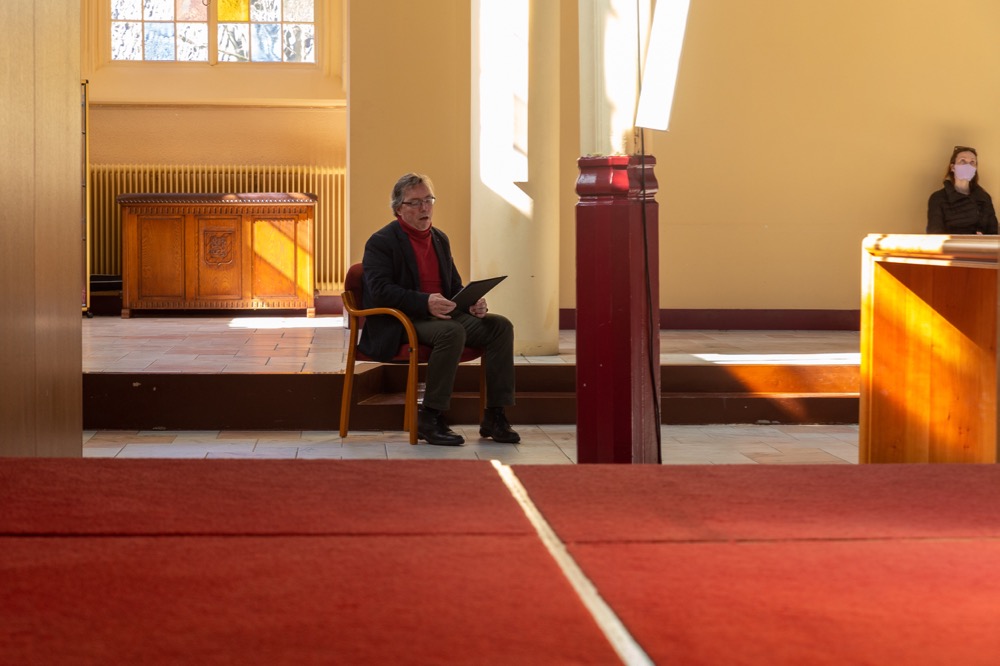
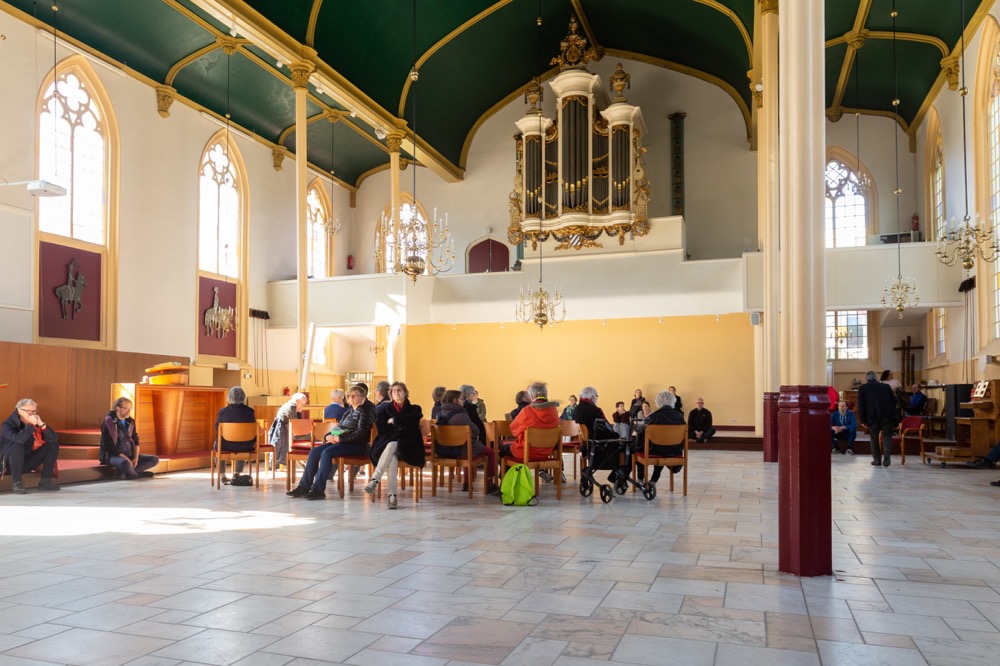
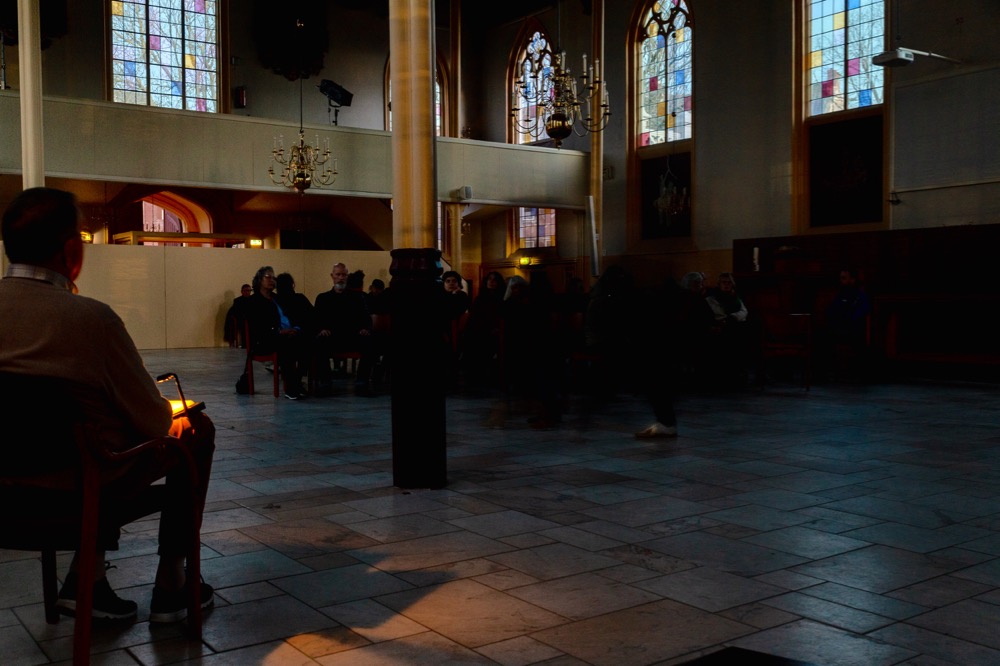
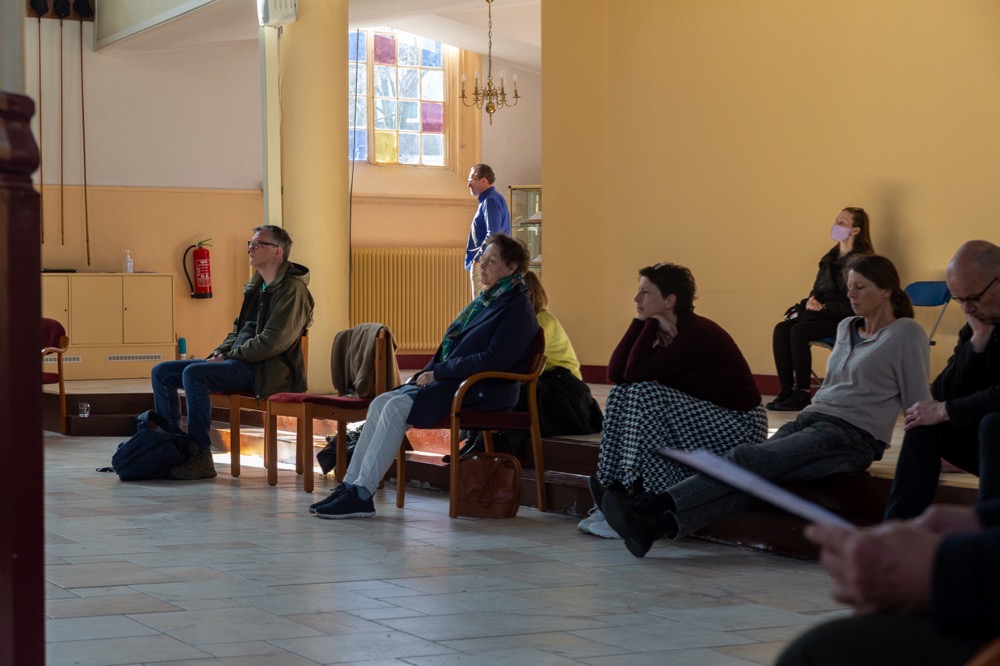
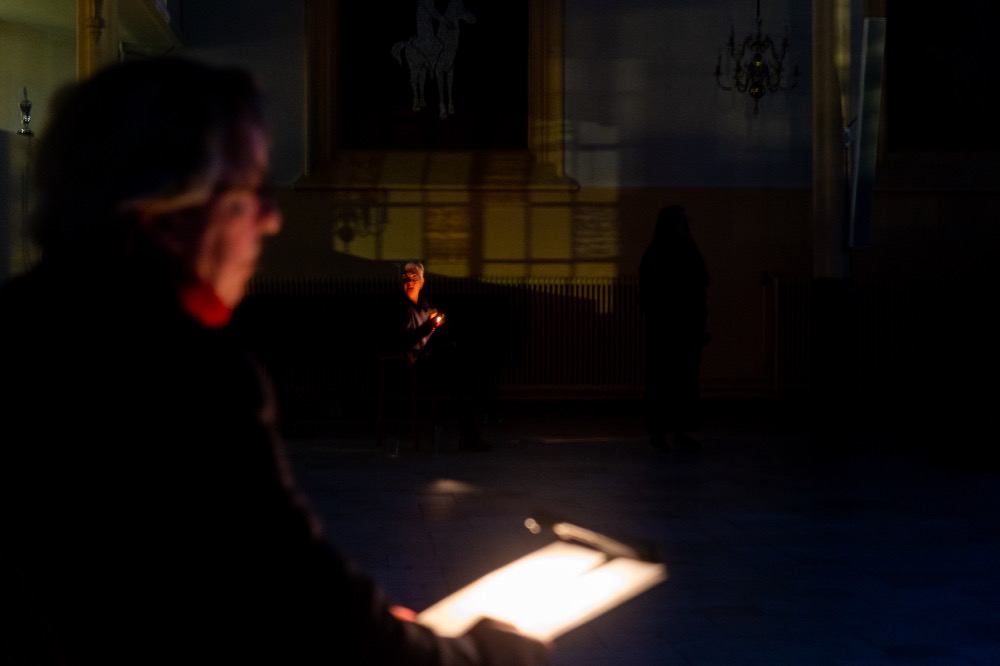
rite 2022
fragm. De Profundis 00.00 / 24.00 2 min
rite 2022
Ubi Caritas 12.00 2 min
rite 2022
Misericordias Domini 18.00 fragm 2min.